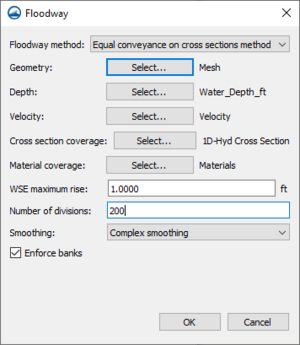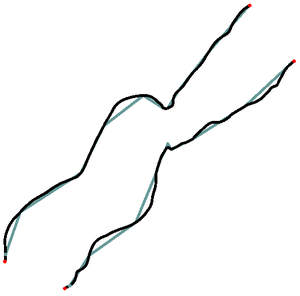User:Jmonson/Floodway delineation: Difference between revisions
From XMS Wiki
Jump to navigationJump to search
No edit summary |
|||
| Line 27: | Line 27: | ||
;Initial Flux | ;Initial Flux | ||
:This is a percentage of the total flow. The initial flux is the percentage of flow that the method will attempt first, as this is an iterative process. The method will determine how far in from both sides that vertical walls can be placed and raise the center flow by only 1 foot. | :This is a percentage of the total flow. The initial flux is the percentage of flow that the method will attempt first, as this is an iterative process. The method will determine how far in from both sides that vertical walls can be placed and raise the center flow by only 1 foot. The method determines the point where the initial flux has been reached from the closest bank, and then simulates a vertical wall and eliminates the flow area between this point and the closest dry bank. The center flow area is increased until the flow area times its velocity accounts for the total flow. | ||
:If the increased depth is lower than the acceptable range, the percentage of flux is increased and the computations repeated. If the increased depth is higher than the acceptable range, the flux percentage is reduced and the computations repeated. If it is within the acceptable range, the method is complete. The default value is "5.0". | |||
[[File:Flow trace example for Floodway.png|thumb|right|The smoother arcs were created using flow trace.]] | [[File:Flow trace example for Floodway.png|thumb|right|The smoother arcs were created using flow trace.]] | ||
Revision as of 21:16, 18 January 2018
| This contains information about functionality available starting at SMS version 13.0. The content may not apply to other versions. |
Floodway delineation is the process by which an area is marked for use as a floodway. The Federal Emergency Management Agency (FEMA) defines a floodway as follows:
A "Regulatory Floodway" means the channel of a river or other watercourse and the adjacent land areas that must be reserved in order to discharge the base flood without cumulatively increasing the water surface elevation more than a designated height.[1]
Floodway Dialog
The Floodway tool in SMS is used to delineate approximate floodway extent arcs based on the geometry of the mesh used in the project.
- Geometry
- A mesh or scatter set must be selected. Click Select... to bring up the Select Tree Item dialog. It will display any appropriate datasets.
- Depth
- A depth dataset must be selected. This dataset should the one from under the selected mesh. Click Select... to bring up the Select Tree Item dialog. It will display any appropriate datasets.
- Velocity
- A velocity dataset must be selected. This dataset should the one from under the selected mesh. Click Select... to bring up the Select Tree Item dialog. It will display any appropriate datasets.
- Cross Section Coverage
- A cross section coverage must be selected. Click Select... to bring up the Select Tree Item dialog. It will display any appropriate datasets.
- WSE Maximum Rise
- The desired maximum rise in water surface elevation. FEMA's maximum allowable rise criterion is 1 foot or less. The default value is "1.0".
- WSE Minimum Rise
- The desired minimum rise in water surface elevation. The default value is "0.9995".
- Initial Flux
- This is a percentage of the total flow. The initial flux is the percentage of flow that the method will attempt first, as this is an iterative process. The method will determine how far in from both sides that vertical walls can be placed and raise the center flow by only 1 foot. The method determines the point where the initial flux has been reached from the closest bank, and then simulates a vertical wall and eliminates the flow area between this point and the closest dry bank. The center flow area is increased until the flow area times its velocity accounts for the total flow.
- If the increased depth is lower than the acceptable range, the percentage of flux is increased and the computations repeated. If the increased depth is higher than the acceptable range, the flux percentage is reduced and the computations repeated. If it is within the acceptable range, the method is complete. The default value is "5.0".
- Use flow trace
- Checking this box turns on flow trace. Flow trace will create smoother floodway extent arcs between each cross section.
References
- ^ "Floodway". Federal Emergency Management Agency. July 18, 2017. https://www.fema.gov/floodway. Retrieved on January 10, 2018.

